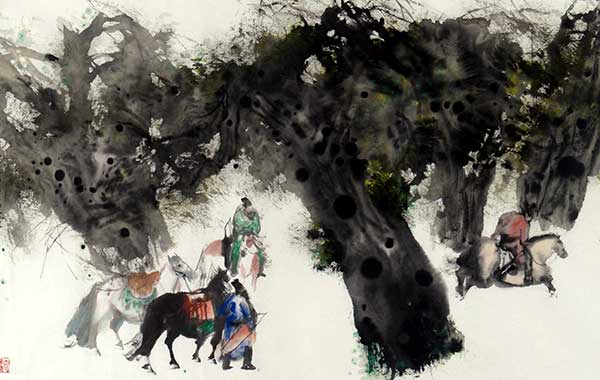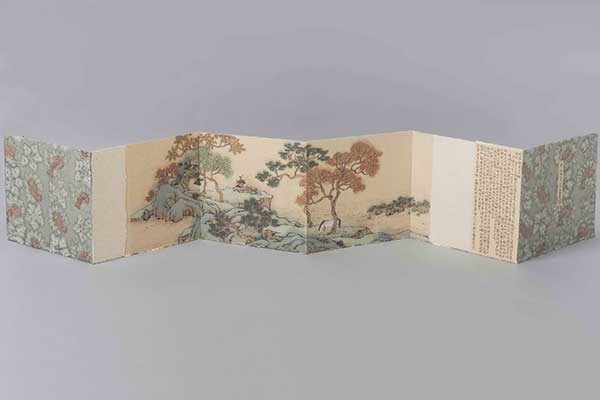
A traditional Chinese water-and-ink painting by Peng Xiancheng.[Photo provided to China Daily]
For many years, seeking to avoid comparison, artist Peng Wei has been unwilling to hold a show jointly with her father, Peng Xiancheng, who gained fame for traditional Chinese water-and-ink paintings decades ago. Now the daughter is finally stepping forward to present her works and her father’s together for the first time, confident she has developed her own artistic style.
Peng Wei, 41, and her father, 74, both do water-and-ink paintings. However, the father focuses on traditional Chinese paintings while the daughter paints on shoes, plastic bodies and clothes, a kind of installation art.
About 40 of their works are on display at Sotheby’s S2 gallery in Hong Kong. The ink art of two generations is “a special way to show her respect and love for her father”, says Peng Wei.
Kevin Ching, CEO of Sotheby’s Asia, says the father and daughter are very different in style and presentation of ink arts.

One of Peng Wei’s installations features a painting on a mannequin.[Photo provided to China Daily]
“They grew up in different times and developed their styles in different directions. We can feel the love between them and their works,” Ching says.
Peng Wei’s Letters From a Distance include several long scrolls featuring landscape paintings accompanied by calligraphy of letters translated from master composer Mozart’s letters to his father.
One traditional ink painting on scroll depicts a father walking in the night with his little girl and another shows a general in ancient times reading a letter from home.
“Mozart often wrote to his father, talking about his jobs and his girlfriend in letters. The close relationship between him and his father is like mine with my father,” Peng says.
“Before going to university, I never left my father. The letters are a metaphor to show me missing my father.”
Born into a family of artists, Peng started painting at 3. Wherever her father went, he would take her with him.

Artwork from Peng’s Letters From a Distance.[Photo provided to China Daily]
“We feel we’re born to do ink paintings. Painting is as important as having meals for us,” says Peng at her Beijing studio. Her father lives in Chengdu in Sichuan province.
Her father is known for his ink painting skill known as meigu that puts ink directly on paper without sketching out the objects first. He held a lot of shows in and outside China in the early 1990s. His favorite subjects are birds and flowers, figures and landscapes.
For a long time, Peng was introduced as the daughter of her artist father. When she started her installations by painting on shoes, boots, clothes and the plastic bodies and limbs of female mannequins, she won recognition and her works are now collected by many museums and galleries around the world.
She has been deeply influenced by conceptual art from the West. She says water and ink are just a medium for her to create works. She has painted copies of Chinese ink paintings done in ancient times onto different objects.
In 2011, Peng did erotic paintings inside silk shoes. She believes shoes are very private objects for women, and to some extent, silk shoes in ancient China were often associated with love and sex. Later, she devoted herself to works on other symbols of women’s privacy, such as clothes and plastic body parts.
The mix of contemporary art and traditional Chinese water and ink painting quickly made Peng stand out in the art world. She has held solo shows in many museums on the mainland, at Art Basel and in the National Museum of History in Taiwan.
The female aesthetic in her works has also attracted many luxury brands like Gurlain, Chinese clothing brand Exception and Italian shoe brand Sergio Rossi to work with her.
Peng says her skills in ink painting are largely influenced by her father, but she has finally developed her own style. They are separate individuals in art world.
But one thing remains the same: She and her father devote every possible minute to painting.
“It’s a funny game for me,” she says.
She also paints many stones, which she says have a resemblance to her father: Stones change when looked at from different angles, but they are still the same stones.
